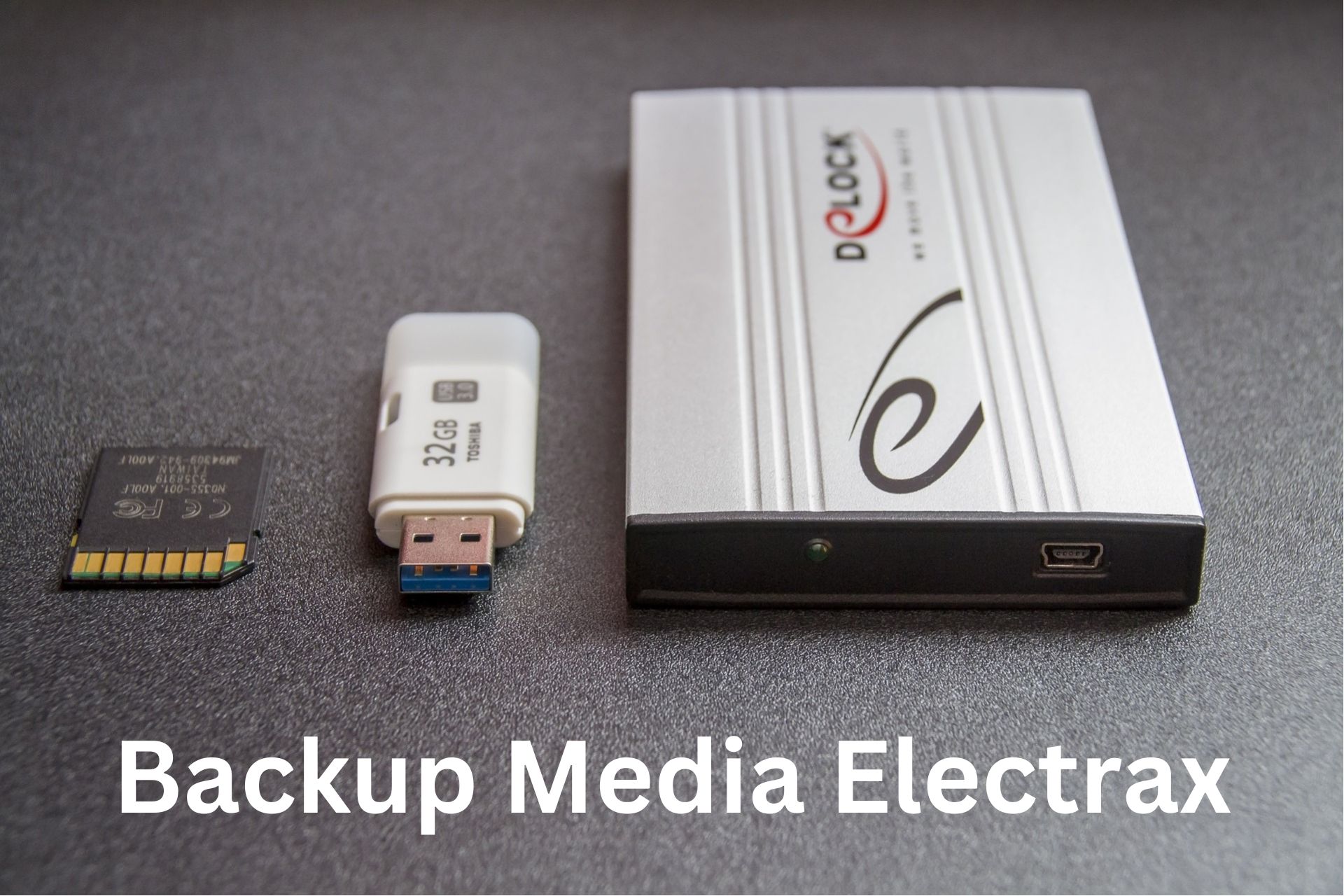In our digital age, the safety of your data is paramount. Whether it’s cherished memories captured in photos, critical business documents, or invaluable creative works, ensuring reliable data backups is non-negotiable. Backup Media Electrax may not be a widely recognized term, but it represents a sophisticated solution designed to keep your data secure from loss. This article will delve deep into the meaning of Backup Media Electrax, its importance, how it functions, the various types of media it employs, and best practices for utilizing it effectively.
Contents
- 1 1. What is Backup Media Electrax?
- 2 2. Why is Data Backup Important?
- 3 3. How Does Backup Media Electrax Work?
- 4 4. Types of Backup Media Associated with Electrax
- 5 5. Benefits of Using Backup Media Electrax
- 6 6. Choosing the Right Backup Solution
- 7 7. Best Practices for Data Backup
- 8 8. Future Trends in Backup Technology
- 9 9. Conclusion: The Importance of Backup Media Electrax
- 10 10. FAQs
1. What is Backup Media Electrax?
Backup Media Electrax refers to a comprehensive data backup solution or software specifically designed to create secure copies of essential data. This can include everything from personal photographs to important business documents, and other critical files that users cannot afford to lose. While “Electrax” may represent a brand or a specific technology associated with data backup solutions, the primary focus is on the underlying principles of data preservation and recovery.
The term itself may evoke thoughts of advanced technology—possibly integrating various methods of backup, including cloud storage, local hard drives, and other secure methods of data preservation. Understanding the full scope of what Backup Media Electrax entails requires looking at both its functional aspects and the broader context of data management in today’s world.
2. Why is Data Backup Important?
Data loss can occur suddenly and unexpectedly, and its implications can be devastating. From personal files to business-critical information, losing data can result in significant emotional and financial stress. Here are some compelling reasons why data backup is crucial:
2.1 Protection Against Hardware Failure
One of the most common causes of data loss is hardware failure. Hard drives, SSDs, and other storage devices are prone to malfunction due to various reasons, including:
- Wear and Tear: Over time, storage devices degrade. Mechanical hard drives, in particular, have moving parts that can fail.
- Power Surges: Unexpected power outages or surges can corrupt data or damage hardware.
- Natural Disasters: Fires, floods, and other disasters can physically destroy storage media.
Regular backups ensure that your data remains safe even if your hardware fails.
2.2 Safeguarding Against Cyber Threats
Cyberattacks are on the rise, with threats like ransomware being particularly dangerous. Ransomware encrypts your files, making them inaccessible unless a ransom is paid. A reliable backup solution, such as Backup Media Electrax, provides a way to restore files without having to negotiate with attackers.
- Malware: Various forms of malware can compromise your data security, making backups essential for recovery.
- Phishing Attacks: Users may inadvertently provide access to their systems. Having backups allows for recovery from unauthorized access.
2.3 Accidental Deletion Prevention
Human error is one of the most common causes of data loss. Files can be accidentally deleted or overwritten. Backups provide a safety net for these situations:
- Mistaken Deletion: Files can be mistakenly deleted while cleaning up storage.
- Version Control: Multiple versions of files can be saved, allowing users to revert to previous versions if necessary.
3. How Does Backup Media Electrax Work?
Understanding how Backup Media Electrax functions is crucial for effective data management. The process typically involves several key steps:
3.1 Data Selection
Users begin by selecting the files or folders they wish to back up. This can include documents, photos, videos, and application data. Some systems allow for:
- Full Backups: Complete copies of all selected data.
- Incremental Backups: Only changes made since the last backup are saved, saving time and storage space.
3.2 Backup Creation
Once the data is selected, Backup Media Electrax creates copies of this data. This process may involve:
- Compression: Reducing the file size to save storage space.
- Encryption: Securing data during transfer to protect against unauthorized access.
3.3 Storage
The backup is stored on a specified medium, which could be:
- Local Storage: Such as external hard drives or USB drives. This option offers fast access but may be vulnerable to physical damage.
- Cloud Storage: Backing up to remote servers via the internet. This method provides off-site protection and accessibility from various devices.
3.4 Scheduling
Backup Media Electrax allows users to schedule backups to occur automatically at regular intervals. This ensures that new data is consistently protected without requiring manual intervention.
3.5 Recovery
If data loss occurs, users can restore lost files using the backup. This may involve:
- Simple Restoration: Restoring selected files or folders.
- Full System Restore: In more complex scenarios, entire systems can be restored to their previous state.
4. Types of Backup Media Associated with Electrax
Backup Media Electrax may involve various types of storage media, each with its advantages and disadvantages. Understanding these options is vital for selecting the best solution for your needs:
4.1 External Hard Drives
- Pros: Large storage capacity, relatively affordable, easy to use.
- Cons: Physical damage risk, requires manual connection to computers.
External hard drives are popular for local backups due to their large storage capacities. They are ideal for home users and businesses needing to back up significant amounts of data.
4.2 Cloud Storage
- Pros: Accessible from anywhere, off-site protection, automatic updates.
- Cons: Requires internet connection, potential subscription costs.
Cloud storage solutions offer the advantage of remote access and off-site storage, which protects against physical threats like fire or theft. This option is highly scalable and convenient for users who travel frequently.
4.3 USB Flash Drives
- Pros: Portable, convenient for quick backups, inexpensive.
- Cons: Limited storage capacity, easy to misplace or lose.
USB drives are compact and easily transportable, making them great for quick, on-the-go backups. However, their limited capacity makes them less ideal for comprehensive data storage.
4.4 Network-Attached Storage (NAS)
- Pros: High storage capacity, accessible across multiple devices, suitable for teams.
- Cons: Higher initial investment, requires technical setup.
NAS systems are suitable for businesses or power users who need to store and access large amounts of data across multiple devices. They can serve as centralized storage solutions for collaborative work environments.
5. Benefits of Using Backup Media Electrax
Utilizing Backup Media Electrax offers numerous benefits that enhance your overall data management strategy:
5.1 Reliability
High-quality backup solutions ensure that your data is consistently protected. Regular updates and monitoring help maintain data integrity and availability.
5.2 Ease of Use
Many backup software solutions are user-friendly, making it easy for individuals and businesses to set up and manage their backups without extensive technical knowledge.
5.3 Automatic Backups
Automated backup scheduling reduces the risk of forgetting to back up important data, ensuring that users are consistently protected against data loss.
5.4 Quick Recovery
In the event of data loss, backups allow for rapid recovery, minimizing downtime and stress. This is especially critical for businesses, where data loss can lead to significant operational disruptions.
6. Choosing the Right Backup Solution
When selecting a backup solution, it’s essential to consider your specific needs. Backup Media Electrax may be suitable if you’re looking for a comprehensive and reliable way to protect your data. Here are some factors to consider:
6.1 Storage Capacity
Ensure the backup media can handle the volume of data you need to protect. Assess current storage requirements and anticipate future growth to select an appropriate solution.
6.2 Security Features
Look for solutions that offer encryption and secure storage to protect your data from unauthorized access. Implementing robust security measures is vital to prevent data breaches.
6.3 Compatibility
Verify that the backup solution is compatible with your operating system and devices. Check for cross-platform functionality if you use different systems.
6.4 Support and Updates
Opt for software that offers regular updates and customer support to ensure ongoing protection. A responsive support team can help resolve issues quickly, minimizing downtime.
7. Best Practices for Data Backup
Implementing effective data backup strategies is crucial for maintaining data security. Here are some best practices to consider:
7.1 Use the 3-2-1 Backup Rule
This rule recommends having three copies of your data on two different types of media, with one copy stored off-site. This approach minimizes the risk of data loss due to hardware failure or natural disasters.
7.2 Test Your Backups Regularly
Regularly test your backups to ensure they are functioning correctly and that data can be restored as expected. This practice helps identify any issues before a data loss situation arises.
7.3 Keep Software Updated
Ensure that your backup software is up to date to protect against vulnerabilities. Regular updates often include security patches and enhancements that improve performance.
7.4 Educate Users
If you are managing data for a team or organization, educate users on the importance of data backup and best practices. Awareness can prevent accidental data loss.
8. Future Trends in Backup Technology
The field of data backup is continually evolving. Here are some emerging trends to watch:
8.1 Cloud Integration
More organizations are moving towards hybrid solutions that combine local and cloud storage, providing flexibility and enhanced security.
8.2 AI and Machine Learning
Artificial intelligence is being integrated into backup solutions to optimize data management, automate backups, and improve recovery processes.
8.3 Blockchain Technology
Blockchain can enhance data integrity by providing a secure, immutable record of backups. This technology can help in verifying that backups have not been tampered with.
9. Conclusion: The Importance of Backup Media Electrax
In a world where data is invaluable, Backup Media Electrax offers an essential solution for protecting your digital assets. Its reliable, user-friendly approach to data backup ensures that individuals and businesses can safeguard their information against loss. By understanding the principles of data backup and implementing best practices, users can enjoy peace of mind knowing their data is secure.
10. FAQs
10.1 What is the best type of backup media?
The best type of backup media depends on your needs. For comprehensive data protection, a combination of cloud storage and external hard drives is often recommended.
10.2 How often should I back up my data?
Regular backups are essential. Ideally, you should perform backups daily or weekly, depending on the frequency of data changes.
10.3 Can I recover deleted files with backup media?
Yes, backup media allows for recovery of deleted files as long as they were included in the backup before deletion.
10.4 Is cloud backup safe?
Cloud backups are generally safe, especially when using reputable providers with strong security measures, including encryption.
10.5 How do I choose a backup solution?
Consider factors like storage capacity, security features, compatibility, and support when selecting a backup solution that meets your needs.











